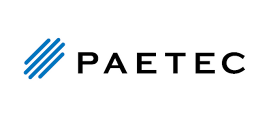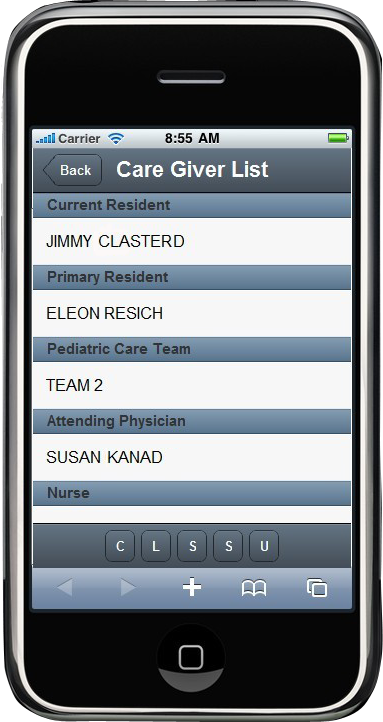Case Study: Mobile Healthcare

Overview
SaaSafras healthcare applications developed for PAETEC are in use at a major hospital. The first, built using the M2M mobile web application framework, enables clinicians at the bedside to use their mobile devices or tablets to look up patient information, identify patient's assigned caregivers and determine if they are available for consultation. The application can then initiate communications automatically using the hospital's PBX to save on toll charges, or the clinician can select a context-specific template and quickly send out an IM or email without the need for typing.
The second application extends a patient portal from the hospital Electronic Health Records (EHR) system to mobile tablets. Clinicians can now view all critical patient information in real-time, update/edit data, and easily graph charts. Through an integrated resource locator tab, Clinicians can also quickly find the available caregivers for a patient and initiate communications through an embedded instant messaging client, enabling them to collaborate and view patient data at the same time.
Situation
PAETEC approached SaaSafras with a project for one of its clients, a major regional hospital. The hospital works with or employs 1500 clinicians, all of whom are mobile - the hospital is in effect their "office". Close collaboration between primary care physician, specialists, nurses, care teams, and clinical technicians - a requirement for patient care - had become a challenge as the hospital grew:
- Nurses complained that new patients would transfer to their departments with inadequate documentation, and that they spent too much time tracking down the responsible physician for more information.
- Physicians complained that they could not access patient information where they needed it most - at the bedside.
- All clinicians felt that the current paper/email-based system for distributing on-call information that identified resources available for consultation, was outdated. In many cases, nurses had to keep hand-written notes that they updated through the day to keep track of who was available.
Even in cases where the clinician responsible for a patient was known, contacting the individual was extremely difficult. The implementation of a variety of legacy notification solutions, combined with the clinicians' own personal communication devices, had resulted in each clinician carrying a utility belt of pagers, text devices, wireless hospital phones, and personal cell phones. Since the hospital did not have a central directory linking each clinician to the multitude of communication devices they carried, critical collaboration to discuss patient care would often be delayed for hours at a time.
The issue had become critical as the hospital was in the midst of an expansion that would more than double its physical size, making the challenge of information access and collaboration even more acute. The hospital wanted PAETEC to develop and roll-out a mobile strategy that would consolidate all communication channels and hospital information access into a single, hospital-issued mobile device (smartphone for nurses/technicians, tablets for physicians). PAETEC approached SaaSafras to help create the mobile applications to meet this need.
Solution

SaaSafras used BPM on top of enterprise messaging bus to integrate with the hospital EHR (Electronic Health Records), the On-Call scheduling system, and multiple contact databases and directories using either native APIs or web services. With real-time links to both patient data and clinician schedules in place, SaaSafras then implemented a communication platform to centralize the following hospital communication channels:
- Hospital Avaya PBX system to centralize phone calls - initiated either through the mobile device cellular phone plan, or if equipped with a SIP client, directly handled by the PBX to the mobile device through the hospital wireless network;
- Microsoft Exchange for Email notifications;
- Microsoft OCS for instant messaging and text chat
By centralizing communications, SaaSafras was able to consolidate all user communications into a single contact database that each clinician could update directly from their mobile device. If a clinician chose to forward their calls to a new device for the day, other clinicians trying to reach them would not need to be aware of the update - all communications would automatically route to the latest contact.
SaaSafras then created an HTML5 web application that could be used not only on the Apple iOS devices standardized by the hospital, but also Android and any other HTML 5 capable mobile device. The application, linked back to the EHR and On-Call systems, provided a resource locator service that enabled a clinician at the patient bedside to quickly look up patient information, identify the primary care physician, nurse, and care team responsible for the patient, and determine whether any of them were on-call for consultation. Using the implemented communication platform, they could then initiate communications using email, Instant Messaging, or phone. Since Communicator centralized all communications, this provided the hospital with an audit trail for all patient-related collaboration regardless of channel.
In pilot tests, SaaSafras discovered that nurses had a very strong preference for text communications. Working with the head nurses of key departments, SaaSafras created a text menu system that allowed the clinician to select messages based on patient context - the application would then automatically fill out the text message and insert context information as needed (i.e. based on the patient identified in the application), saving significant time and improving communications by standardizing common requests.
SaaSafras then developed a patient portal, extending the EHR system to the mobile tablets used by the physicians. From the tablet, physicians could now view, edit, and even chart patient information. All patient-related information is available as separate data widgets arranged by default in an SBAR format, but customizable by each clinician:
- Patient data
- Problem lists
- Medication
- Events
- Vital signs
- I/Os
- Labs
- Pending/Positive/Negative Micros
- Lab orders
SaaSafras then integrated the Resource Locator service into the Patient Portal, enabling the physician to quickly look up a resource, initiate contact using phone or IM, and have a complete collaboration session - while still being able to view patient information on the portal.
Benefits
The hospital achieved their goal of unifying communications onto a standard hospital issued mobile device. With the opening of the new hospital wing, patient care delays due to collaboration delays have been dramatically reduced, and physicians now have access to both critical patient information as well as resource contacts where they need it the most - at the patient bedside.
For PAETEC, the SaaSafras solution - developed under the PAETEC umbrella - effectively demonstrated their ability to meet the needs of their clients. The solution helped PAETEC position themselves in the market as a "Goto" enterprise business solution provider that is differentiated from, and a level above, other telecom-oriented system integrators.

